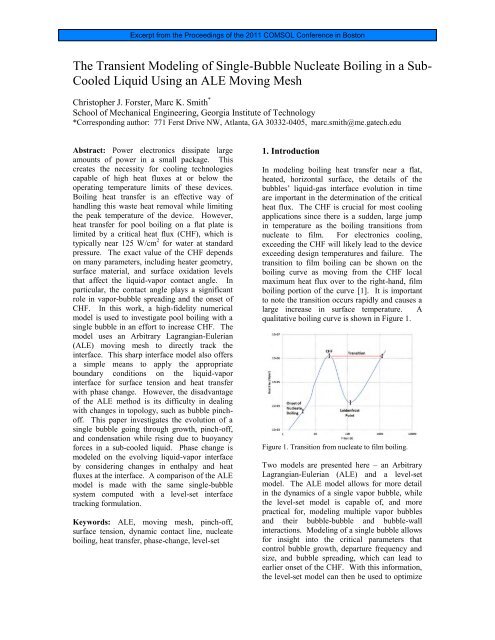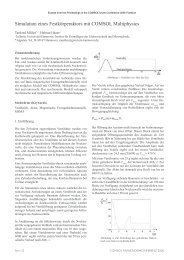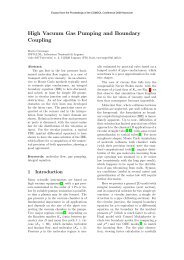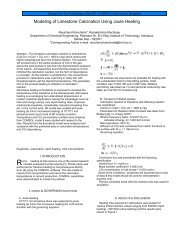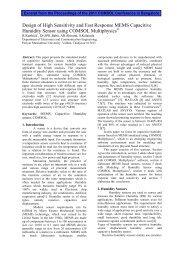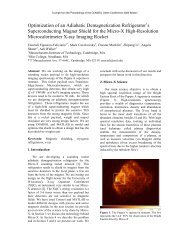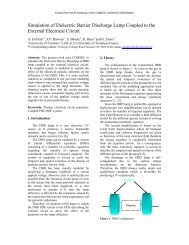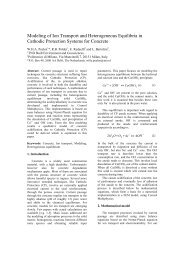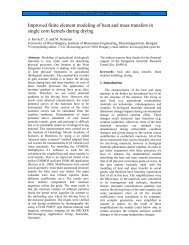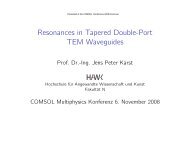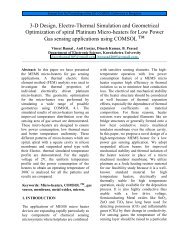The Transient Modeling of Single-Bubble Nucleate ... - COMSOL.com
The Transient Modeling of Single-Bubble Nucleate ... - COMSOL.com
The Transient Modeling of Single-Bubble Nucleate ... - COMSOL.com
You also want an ePaper? Increase the reach of your titles
YUMPU automatically turns print PDFs into web optimized ePapers that Google loves.
<strong>The</strong> <strong>Transient</strong> <strong>Modeling</strong> <strong>of</strong> <strong>Single</strong>-<strong>Bubble</strong> <strong>Nucleate</strong> Boiling in a Sub-<br />
Cooled Liquid Using an ALE Moving Mesh<br />
Christopher J. Forster, Marc K. Smith *<br />
School <strong>of</strong> Mechanical Engineering, Georgia Institute <strong>of</strong> Technology<br />
*Corresponding author: 771 Ferst Drive NW, Atlanta, GA 30332-0405, marc.smith@me.gatech.edu<br />
Abstract: Power electronics dissipate large<br />
amounts <strong>of</strong> power in a small package. This<br />
creates the necessity for cooling technologies<br />
capable <strong>of</strong> high heat fluxes at or below the<br />
operating temperature limits <strong>of</strong> these devices.<br />
Boiling heat transfer is an effective way <strong>of</strong><br />
handling this waste heat removal while limiting<br />
the peak temperature <strong>of</strong> the device. However,<br />
heat transfer for pool boiling on a flat plate is<br />
limited by a critical heat flux (CHF), which is<br />
typically near 125 W/cm 2 for water at standard<br />
pressure. <strong>The</strong> exact value <strong>of</strong> the CHF depends<br />
on many parameters, including heater geometry,<br />
surface material, and surface oxidation levels<br />
that affect the liquid-vapor contact angle. In<br />
particular, the contact angle plays a significant<br />
role in vapor-bubble spreading and the onset <strong>of</strong><br />
CHF. In this work, a high-fidelity numerical<br />
model is used to investigate pool boiling with a<br />
single bubble in an effort to increase CHF. <strong>The</strong><br />
model uses an Arbitrary Lagrangian-Eulerian<br />
(ALE) moving mesh to directly track the<br />
interface. This sharp interface model also <strong>of</strong>fers<br />
a simple means to apply the appropriate<br />
boundary conditions on the liquid-vapor<br />
interface for surface tension and heat transfer<br />
with phase change. However, the disadvantage<br />
<strong>of</strong> the ALE method is its difficulty in dealing<br />
with changes in topology, such as bubble pinch<strong>of</strong>f.<br />
This paper investigates the evolution <strong>of</strong> a<br />
single bubble going through growth, pinch-<strong>of</strong>f,<br />
and condensation while rising due to buoyancy<br />
forces in a sub-cooled liquid. Phase change is<br />
modeled on the evolving liquid-vapor interface<br />
by considering changes in enthalpy and heat<br />
fluxes at the interface. A <strong>com</strong>parison <strong>of</strong> the ALE<br />
model is made with the same single-bubble<br />
system <strong>com</strong>puted with a level-set interface<br />
tracking formulation.<br />
Keywords: ALE, moving mesh, pinch-<strong>of</strong>f,<br />
surface tension, dynamic contact line, nucleate<br />
boiling, heat transfer, phase-change, level-set<br />
1. Introduction<br />
In modeling boiling heat transfer near a flat,<br />
heated, horizontal surface, the details <strong>of</strong> the<br />
bubbles’ liquid-gas interface evolution in time<br />
are important in the determination <strong>of</strong> the critical<br />
heat flux. <strong>The</strong> CHF is crucial for most cooling<br />
applications since there is a sudden, large jump<br />
in temperature as the boiling transitions from<br />
nucleate to film. For electronics cooling,<br />
exceeding the CHF will likely lead to the device<br />
exceeding design temperatures and failure. <strong>The</strong><br />
transition to film boiling can be shown on the<br />
boiling curve as moving from the CHF local<br />
maximum heat flux over to the right-hand, film<br />
boiling portion <strong>of</strong> the curve [1]. It is important<br />
to note the transition occurs rapidly and causes a<br />
large increase in surface temperature. A<br />
qualitative boiling curve is shown in Figure 1.<br />
Figure 1. Transition from nucleate to film boiling.<br />
Two models are presented here – an Arbitrary<br />
Lagrangian-Eulerian (ALE) and a level-set<br />
model. <strong>The</strong> ALE model allows for more detail<br />
in the dynamics <strong>of</strong> a single vapor bubble, while<br />
the level-set model is capable <strong>of</strong>, and more<br />
practical for, modeling multiple vapor bubbles<br />
and their bubble-bubble and bubble-wall<br />
interactions. <strong>Modeling</strong> <strong>of</strong> a single bubble allows<br />
for insight into the critical parameters that<br />
control bubble growth, departure frequency and<br />
size, and bubble spreading, which can lead to<br />
earlier onset <strong>of</strong> the CHF. With this information,<br />
the level-set model can then be used to optimize
heater configurations in more practical and<br />
<strong>com</strong>plicated cooling applications.<br />
2. Use <strong>of</strong> <strong>COMSOL</strong> Multiphysics<br />
2.1 Initial Model Geometry, Initial<br />
Conditions, and Boundary Conditions<br />
<strong>The</strong> bubble begins as a spherical-cap, attached<br />
bubble at the bottom <strong>of</strong> the tank. <strong>The</strong> initial<br />
configuration is shown in Figure 2. <strong>The</strong> gravity<br />
force and heat flux are ramped in over relatively<br />
short time scales, 0.05s and 0.1s, respectively.<br />
This allows the solver to start more easily, and it<br />
allows condensation to be more directly<br />
observable before the heat flux input to the<br />
bottom <strong>of</strong> the tank has been fully ramped in.<br />
<strong>The</strong> temperature pr<strong>of</strong>ile is initially linearly<br />
varied from saturation temperature at the hot<br />
surface to a sub-cooled temperature at the upper<br />
boundary. <strong>The</strong> amount <strong>of</strong> sub-cooling can be<br />
adjusted, but for this model it is set at 5K, which<br />
is reasonable for boiling experiments. <strong>The</strong> initial<br />
velocity field is zero, and the initial pressure<br />
field is uniform over each subdomain, with the<br />
bubble pressure increased by the Laplace<br />
pressure jump. This pressure field is appropriate<br />
for zero initial gravity, before gravity is ramped<br />
in, and the equilibrium, spherical-cap bubble<br />
shape. <strong>The</strong> model is axisymmetric.<br />
Figure 2. Initial model configuration.<br />
<strong>The</strong> hydrodynamic boundary conditions will be<br />
listed first. <strong>The</strong> hot plate is modeled as a slip<br />
boundary with a fixed contact angle, but each<br />
domain can be set to slip or no-slip<br />
independently. Future models may incorporate a<br />
contact line mobility model to more accurately<br />
capture the contact line dynamics, but for now<br />
the two extremes <strong>of</strong> slip and no-slip are easily<br />
modeled. <strong>The</strong> upper tank boundary is set to zero<br />
gage pressure. <strong>The</strong> right-hand tank wall is set to<br />
a slip boundary condition. <strong>The</strong> vapor-liquid<br />
interface enforces a no-slip condition for the<br />
tangential velocity <strong>com</strong>ponent. <strong>The</strong> normal<br />
velocity <strong>com</strong>ponent accounts for the divergence<br />
due to vaporization occurring at the interface.<br />
<strong>The</strong> Young-Laplace normal stress jump is<br />
modeled. <strong>The</strong> vapor recoil pressure can be<br />
included, but it was chosen to be neglected in<br />
this model. <strong>The</strong> inclusion <strong>of</strong> vapor recoil<br />
pressure makes the model more unstable, and for<br />
lower heat inputs, the vapor recoil pressure is<br />
negligible. Vapor recoil pressures were observed<br />
to be on the order <strong>of</strong> 1 Pa while pressure from<br />
surface tension is approximately 50 Pa. <strong>The</strong><br />
vapor recoil effect may be more significant at<br />
higher heat inputs.<br />
In each thermal domain, the interface is required<br />
to remain at the saturation temperature, which is<br />
prescribed to be 373.15K to represent boiling at<br />
standard pressure. <strong>The</strong> saturation temperature<br />
can be a function <strong>of</strong> pressure, but the slight<br />
variations in saturation temperature due to<br />
pressure variations are neglected here. <strong>The</strong><br />
energy balance at the interface is maintained by<br />
the rate <strong>of</strong> vaporization or condensation. <strong>The</strong><br />
heat fluxes are calculated on each side <strong>of</strong> the<br />
interface and the difference determines the rate<br />
<strong>of</strong> vaporization or condensation. <strong>The</strong> hot plate<br />
has a heat flux input prescribed to be 0.2 W/cm 2<br />
under the vapor bubble and 20 W/cm 2<br />
everywhere else. This choice is somewhat<br />
arbitrary, and the reason behind choosing a nonuniform<br />
heat flux is discussed in the results<br />
section. <strong>The</strong> model can be modified to include<br />
another domain for the heat transfer model <strong>of</strong> the<br />
solid heater plate to determine the distribution <strong>of</strong><br />
heat between the bubble and the surrounding<br />
liquid. This paper is focused on presenting the<br />
interface conditions and modeling <strong>of</strong> the phasechange,<br />
so the additional domain for the heater<br />
plate is omitted for clarity. <strong>The</strong> right-hand side<br />
<strong>of</strong> the tank is modeled as thermally-insulated.<br />
<strong>The</strong> upper tank boundary is held at the saturation<br />
temperature minus the amount <strong>of</strong> sub-cooling,<br />
which is 368.15K for this model.
2.2 Pinch-<strong>of</strong>f Transition<br />
Leading up to pinch-<strong>of</strong>f the ALE model is run<br />
with remeshing periodically to maintain mesh<br />
quality. <strong>The</strong> pinch-<strong>of</strong>f point is chosen near the<br />
minimum neck radius for this simulation. A<br />
reasonable gap height is chosen between the<br />
attached and pinched bubble to prevent creating<br />
excessively small elements in the pinched region.<br />
<strong>The</strong> final geometry <strong>of</strong> the attached bubble<br />
simulation is exported to Matlab as an array <strong>of</strong><br />
points with the pinch-<strong>of</strong>f points inserted. <strong>The</strong><br />
boundary points are spline-fit with constraints on<br />
end-point tangency. <strong>The</strong> geometry is imported<br />
back into Comsol and boundary conditions are<br />
transferred from the previous geometry. <strong>The</strong><br />
number <strong>of</strong> fluid domains increases from two to<br />
three domains. Since a finite amount <strong>of</strong> time<br />
occurs during pinch-<strong>of</strong>f, which is not modeled<br />
here, post-pinch-<strong>of</strong>f velocity, pressure, and<br />
temperature fields were estimated in order to<br />
continue the simulation. <strong>The</strong>se estimated initial<br />
conditions after pinch-<strong>of</strong>f are an attempt to<br />
demonstrate that it is possible to continue the<br />
new model where the previous model ended.<br />
<strong>The</strong> pinch-<strong>of</strong>f criteria will be improved in future<br />
work. <strong>The</strong> idea is that when the bubble neck is<br />
small enough, the pinch-<strong>of</strong>f process will be<br />
<strong>com</strong>puted analytically using a separate<br />
asymptotic model. This will reduce numerical<br />
<strong>com</strong>putational requirements due to meshing<br />
regions <strong>of</strong> relatively small length scales<br />
<strong>com</strong>pared to the rest <strong>of</strong> the model. After pinch<strong>of</strong>f,<br />
the shape <strong>of</strong> the gas bubbles and the<br />
associated velocity and pressure fields near the<br />
pinch-<strong>of</strong>f point will be used to reinitialize the<br />
numerical model and continue the simulation.<br />
2.3 Governing Equations for the ALE Model<br />
<strong>The</strong> in<strong>com</strong>pressible Navier-Stokes and<br />
advection-diffusion equations are solved over<br />
each domain. Including the ALE moving mesh,<br />
there are five domains or application modes<br />
modeled in Comsol that are coupled with<br />
boundary conditions. <strong>The</strong> Boussinesq<br />
approximation is used to allow natural<br />
convection with the in<strong>com</strong>pressible fluid model.<br />
<strong>The</strong> ALE method only requires boundary<br />
conditions to be specified to link the liquid and<br />
vapor domains and account for vaporization.<br />
This is different than having to formulate volume<br />
forces and sources as is required in a fixed-mesh<br />
method.<br />
<strong>The</strong> first step in formulating these boundary<br />
conditions is to prescribe the mesh motion so<br />
that it follows the interface evolution. <strong>The</strong> mesh<br />
interface velocity is not the same as either the<br />
local vapor or liquid velocities since there is an<br />
influx/outflux <strong>of</strong> each relative to the interface,<br />
depending on if there is local vaporization or<br />
condensation. <strong>The</strong> mesh is allowed to slide<br />
tangentially along the interface to allow for<br />
improved mesh quality as deformation takes<br />
place, so only a normal <strong>com</strong>ponent needs to be<br />
specified. <strong>The</strong> normal <strong>com</strong>ponents are denoted<br />
with a subscript ‘n’. <strong>The</strong> normal vector<br />
convention is that the outward facing normal<br />
vector is positive, and each domain has its own<br />
outward normal. A diagram <strong>of</strong> the domain and<br />
normal vectors are shown in Figure 3. <strong>The</strong><br />
normal velocity <strong>of</strong> the mesh is given by<br />
̂ (1)<br />
Figure 3. Liquid and Vapor domains with labeled<br />
boundary conditions and heat flux input at hot plate.<br />
where is the relative normal liquid velocity<br />
to the interface, and it is calculated by taking the<br />
difference <strong>of</strong> heat flux on each side <strong>of</strong> the<br />
interface and using liquid and vapor enthalpies<br />
and densities in the calculation. <strong>The</strong> sign<br />
convention used assumes vaporization has a<br />
positive liquid velocity relative to the interface<br />
(i.e., liquid influx is positive). This calculation<br />
will be discussed in more detail later, after the<br />
thermal boundary conditions.
<strong>The</strong> next step is to couple the vapor and liquid<br />
domain velocities at the interface. <strong>The</strong> tangential<br />
<strong>com</strong>ponents are equal, assuming a no-slip<br />
condition. <strong>The</strong> normal <strong>com</strong>ponents differ by the<br />
sum <strong>of</strong> the magnitudes <strong>of</strong> the vapor and liquid<br />
velocities relative to the interface (i.e., the<br />
relative velocities are defined with the observer<br />
attached to the moving interface). <strong>The</strong>se<br />
constraints, in terms <strong>of</strong> normal <strong>com</strong>ponents, are<br />
shown in Eqn. 2 and 3.<br />
( ̂) ( ̂) (2)<br />
( ̂ ̂ ) (3)<br />
<strong>The</strong> interface temperatures, in both the liquid and<br />
vapor domains, are set to the local saturation<br />
temperature as Dirichlet boundary conditions.<br />
(4)<br />
With radiation neglected, the amount <strong>of</strong> heat<br />
going into vaporization is the sum <strong>of</strong> the<br />
conduction heat transfer into the inner and outer<br />
sides <strong>of</strong> the interface.<br />
̂ ̂ (5)<br />
<strong>The</strong> relative or flux velocities can now be<br />
calculated using additional property data that can<br />
be temperature and pressure dependent. <strong>The</strong><br />
property data can be represented with a curve-fit<br />
or table interpolation.<br />
( )<br />
( )<br />
(6)<br />
(7)<br />
Vapor recoil may be included by adding the<br />
following terms to the stress boundary condition<br />
on the vapor domain along the interface. <strong>The</strong><br />
boundary stress terms are separated into<br />
projected <strong>com</strong>ponents to allow for incorporation<br />
into the weak form <strong>of</strong> the Navier-Stokes<br />
equations in Comsol Multiphysics. <strong>The</strong><br />
velocities in Eqn. 8 are relative to the interface.<br />
[<br />
]<br />
( ̂ ) ( ̂ ) (8)<br />
<strong>The</strong> normal-stress boundary condition on the<br />
liquid-gas interface is<br />
( ) ̂ ̂ , (9)<br />
where are the stress tensors for the gas and<br />
the liquid, defined as<br />
[ ( ( ) )]<br />
(10)<br />
̂ is the outward unit normal to the gas-liquid<br />
interface, is the surface tension <strong>of</strong> the interface,<br />
and is the curvature <strong>of</strong> the interface defined as<br />
̂, (11)<br />
where is the surface divergence operator. <strong>The</strong><br />
Navier-Stokes equations on the sub-domains<br />
remain unchanged since the surface tension is<br />
implemented as a boundary condition.<br />
Multiplying both sides <strong>of</strong> Eqn. 9 by a test<br />
function and integrating results in,<br />
∫ ( ̃ ̂)<br />
∫ ( ̃ ̂)<br />
∫ ( ̃ ̂)<br />
(12)<br />
Applying the surface divergence theorem [2] to<br />
the last surface integral on the right-hand side<br />
and substituting back in yields,<br />
∫ ( ̃ ̂)<br />
∫ ( ̃ ̂)<br />
∫ ( ̃)<br />
∫ ( ̃ ̂)<br />
(13)<br />
where ̂ is a unit binormal vector at the contact<br />
line, and ̃ is a test function.<br />
This last equation can be applied as boundary<br />
and point weak expressions in Comsol. This<br />
applies to 2D, 2D axisymmetric, and 3D models,<br />
although some minor modifications need to be<br />
made to express this in polar coordinates.<br />
2.4 Governing Equations for the Level-set<br />
Model<br />
<strong>The</strong> finite element level-set model incorporates<br />
phase change in a method similar to Son and<br />
Dhir [3,4], except that a ghost fluid method<br />
cannot be implemented in Comsol Multiphysics<br />
for calculating heat fluxes on the interface. To
account for phase change, terms are added to the<br />
continuity and energy equations only on the<br />
interface using a delta function. Vapor recoil is<br />
accounted for, similarly, by adding a term to the<br />
momentum equation, again only on the interface<br />
using a delta function. <strong>The</strong> temperature recovery<br />
method described in [5] is used to maintain the<br />
saturation temperature on the interface, where<br />
the level-set variable is 0.5. Comsol<br />
Multiphysics uses a level-set variable that varies<br />
between 0 and 1, as opposed to -1 to 1. <strong>The</strong> first<br />
use, to the best knowledge <strong>of</strong> the author, <strong>of</strong> the<br />
temperature recovery method appears in [6].<br />
<strong>The</strong> temperature recovery method works by<br />
proportionally increasing the mass vaporization<br />
(condensation) rate as the local interface<br />
temperature deviates from the saturation<br />
temperature. This is solved at each time step<br />
inside the Comsol solver along with the velocity,<br />
temperature, and level-set fields. In effect, the<br />
temperature recovery method determines the<br />
amount <strong>of</strong> fluid vaporization (condensation)<br />
required to maintain the interface temperature,<br />
rather than calculating the mass vaporization<br />
(condensation) rate directly from the temperature<br />
gradients on each side <strong>of</strong> the interface, since<br />
these gradients are not available and not<br />
accurately <strong>com</strong>puted without using a ghost fluid<br />
method. <strong>The</strong> mass vaporization (condensation)<br />
rate calculated from heat fluxes at the interface<br />
should, in theory, dictate enough vaporization<br />
(condensation) to keep the interface at saturation<br />
temperature. With this in mind, determining the<br />
mass vaporization (condensation) rate to some<br />
value that is enough to maintain the interface<br />
temperature at saturation should lead to the same<br />
result. <strong>The</strong> temperature recovery method has<br />
been verified to maintain interface temperatures<br />
within approximately 0.3 °C. <strong>The</strong> finite element<br />
model utilizes quadratic triangular (tetrahedral<br />
for 3D) Lagrange elements for the fluid, thermal,<br />
and level-set equations. <strong>The</strong> present model does<br />
not account for thin film (micro-scale) boiling,<br />
but a lubrication model can be added in Comsol<br />
Multiphysics and coupled to the current model.<br />
Aside from the temperature recovery method for<br />
determining the mass vaporization<br />
(condensation) rate, the formulation is very<br />
similar to Son and Dhir’s method [3], which is as<br />
follows.<br />
First, the mass vaporization (condensation) rate<br />
is determined from the interface temperature<br />
pr<strong>of</strong>ile, shown in Eqn. 14. Note that ̇ is per<br />
unit interface surface area. <strong>The</strong> proportionality<br />
constant ‘C’ can be adjusted if the vaporization<br />
(condensation) rate is insufficient to maintain<br />
saturation temperature on the interface. Setting<br />
this constant too large will lead to numerical<br />
instabilities.<br />
̇ (<br />
) (14)<br />
Also, the mass vaporization (condensation) rate<br />
can be formulated as an interfacial normal flux,<br />
which is used for the continuity source term on<br />
the interface,<br />
̇ ( ) ̂ (15)<br />
where U is the interface velocity and the<br />
subscript ‘f’ indicates the fluid, which could be<br />
liquid or vapor. <strong>The</strong> next step is to evaluate Eqn.<br />
15 for both the liquid and vapor, and then<br />
rearrange for the liquid and vapor velocities.<br />
Equations 16 and 17 represent the normal<br />
<strong>com</strong>ponents only – vector notation is omitted for<br />
clarity.<br />
̇ (16)<br />
̇ (17)<br />
Taking the difference in the liquid and vapor<br />
velocities at the interface provides the<br />
divergence created by the phase-change and<br />
corresponding change in density. <strong>The</strong> fluid is<br />
treated as in<strong>com</strong>pressible everywhere in the<br />
fluid, except on the interface region, and the<br />
continuity source term is Eqn. 18 multiplied by<br />
an interface delta function that only allows the<br />
source term to be non-zero on the interface.<br />
(<br />
) ̇ ̂ (18)<br />
<strong>The</strong> continuity equation with the additional<br />
source term is shown in Eqn. 19 and 20, where<br />
is the interface delta function.<br />
( ) (19)<br />
(<br />
) ̇ ̂ (20)<br />
<strong>The</strong> tangential stress on the vapor and liquid<br />
sides <strong>of</strong> the interface are equal while there is a
jump condition in the normal stress. <strong>The</strong> normal<br />
stress changes across the interface because <strong>of</strong> the<br />
effects <strong>of</strong> surface tension and vapor recoil. Eqn.<br />
21 prescribes that the tangential stress on each<br />
side <strong>of</strong> the interface is equal. Eqn. 22 is the<br />
normal stress jump condition.<br />
̂ [ ( ) ( ) ] ̂<br />
̂ [ ( )<br />
( ) ] ̂<br />
(<br />
) ̇<br />
(21)<br />
(22)<br />
<strong>The</strong> forces from surface tension and vapor recoil<br />
are added to only the interface region as volume<br />
force terms using the interface delta function.<br />
<strong>The</strong> next step is to account for the latent heat <strong>of</strong><br />
vaporization in the energy equation. This is<br />
done by adding a term, multiplied by the<br />
interface delta function, to account for the energy<br />
liberated (absorbed) by condensation<br />
(vaporization). <strong>The</strong> modified energy equation is<br />
shown in Eqn. 23, where is the latent heat <strong>of</strong><br />
vaporization.<br />
(<br />
) ( ) ̇<br />
(23)<br />
<strong>The</strong> level-set function is updated since it only<br />
accounts for advection <strong>of</strong> the interface by default<br />
– it does not account for interface movement as<br />
vapor phase is generated. <strong>The</strong> modified level-set<br />
function is shown in Eqn. 24.<br />
where,<br />
̇<br />
(24)<br />
̂ (25)<br />
This <strong>com</strong>pletes the necessary modifications to<br />
the finite-element level-set model, and it now<br />
accounts for vaporization and condensation.<br />
3. Results and Discussion<br />
<strong>The</strong> single-bubble models use an initial bubble<br />
radius <strong>of</strong> 3 mm. <strong>The</strong> surface tension coefficient<br />
is 0.07 N/m for all models. Pressure and gravity<br />
are 1atm and 9.81 m/s 2 , respectively.<br />
3.1 ALE Results<br />
<strong>The</strong> heat flux input over the heater surface<br />
exposed to liquid is 20 W/cm 2 and the region <strong>of</strong><br />
the heater surface underneath the vapor bubble is<br />
0.2 W/cm 2 . <strong>The</strong> exterior contact angle is 55<br />
degrees. <strong>The</strong> heat flux is ramped in over 0.1 s.<br />
<strong>The</strong> model is axisymmetric. Figure 4 shows the<br />
temperature distribution with velocity arrows<br />
over-plotted and the interface marked with a<br />
white line at selected time steps.<br />
Figure 4. ALE simulation results for a contact angle <strong>of</strong><br />
55 degrees.<br />
<strong>The</strong> vapor in the bubble reaches relatively high<br />
temperatures even at low heat fluxes. <strong>The</strong> model<br />
was run with 0.2 W/cm 2 input under the vapor<br />
bubble to reduce the peak temperatures in the<br />
vapor domain, which were observed to be in<br />
excess <strong>of</strong> 1000 K at higher heat fluxes. <strong>The</strong><br />
reduced heat flux under the vapor bubble limits<br />
peak vapor temperatures to approximately<br />
450 K. <strong>The</strong> next step is to include another heat<br />
transfer domain to incorporate the solid heater<br />
plate. This will allow for a physical<br />
determination <strong>of</strong> the appropriate heat distribution<br />
under the vapor bubble and the rest <strong>of</strong> the heater<br />
surface exposed to liquid. <strong>The</strong> liquid and vapor<br />
have significantly different thermal<br />
conductivities, so the heat flux is not expected to<br />
be uniform over the entire heater. However, the
heater plate will physically smooth out<br />
temperature gradients along the surface <strong>of</strong> the<br />
heater and between the vapor and liquid. This is<br />
expected because <strong>of</strong> the higher thermal<br />
conductivity in the solid heater plate <strong>com</strong>pared to<br />
water in both liquid and vapor states.<br />
<strong>The</strong> ALE method can also model a pinned<br />
contact line with phase-change. Figure 5 shows<br />
the results from the pinned contact-line model.<br />
Figure 5. ALE results for a pinned contact line.<br />
<strong>The</strong> non-isothermal ALE model requires more<br />
remeshing to reach pinch-<strong>of</strong>f than the previous<br />
isothermal model [7]. This appears to be<br />
primarily due to the addition <strong>of</strong> vaporization and<br />
condensation on the interface. <strong>The</strong> pinch-<strong>of</strong>f<br />
process was not successful due to the solver<br />
being unable to restart with the current<br />
approximated solution on the new geometry after<br />
pinch-<strong>of</strong>f. This is likely to be because the<br />
approximated solution created did not satisfy the<br />
model constraints and boundary conditions<br />
within solver tolerances. <strong>The</strong> intermediate<br />
model proposed would provide a more accurate<br />
solution to resume the model after pinch-<strong>of</strong>f. It<br />
is expected that this would be successful in<br />
continuing the model after pinch-<strong>of</strong>f.<br />
3.2 Level-Set Results<br />
<strong>The</strong> heat flux input over the entire surface <strong>of</strong> the<br />
hot plate is 15 W/cm 2 . <strong>The</strong> exterior contact<br />
angle is 55 degrees, and the hot surface enforces<br />
a slip length condition. <strong>The</strong> model was<br />
performed in 3D and utilized symmetry<br />
conditions to minimize the <strong>com</strong>putational<br />
domain. A 1/8 th vertical wedge was modeled.<br />
This provides similar results to the axisymmetric<br />
case in the ALE model. <strong>The</strong> mesh resolution is<br />
relatively coarse in the level-set model to reduce<br />
<strong>com</strong>putational expense. This is likely to make<br />
the solution mesh-dependent, especially near the<br />
contact line. <strong>The</strong> results in Figure 6 show the<br />
iso-surfaces <strong>of</strong> the level-set function values <strong>of</strong><br />
0.5. <strong>The</strong> heat flux input is started immediately,<br />
without ramping in. <strong>The</strong> liquid is sub-cooled by<br />
5K at the upper tank boundary, and the initial<br />
temperature condition is a linear pr<strong>of</strong>ile from<br />
saturation temperature at the hot surface to the<br />
sub-cooled temperature at the upper tank<br />
boundary.<br />
Figure 6. 3D, 1/8-symmetry model <strong>of</strong> a single vapor<br />
bubble.<br />
<strong>The</strong> level-set model can be extended to multiple<br />
vapor bubbles. <strong>The</strong> next results shown in Figure<br />
7 were performed in 2D to minimize<br />
<strong>com</strong>putational expense. While the 2D model<br />
neglects the second curvature used for<br />
calculating pressure due to surface tension, it<br />
does provide qualitative results for the behavior<br />
<strong>of</strong> the interactions between bubble interactions<br />
and departure frequency.<br />
Figure 7. 2D simulation <strong>of</strong> three nucleation sites.
<strong>The</strong> level-set reinitialization parameter needs to<br />
be chosen carefully since the default value in<br />
Comsol Multiphysics 4.2 tends to introduce a<br />
significant amount <strong>of</strong> interface movement due to<br />
accumulation <strong>of</strong> error in the reinitialization<br />
procedure that occurs at each time step. <strong>The</strong><br />
value <strong>of</strong> the reinitialization parameter is specific<br />
to each problem. It has been found that values<br />
on the order <strong>of</strong> 0.01 or less provide the best<br />
results. <strong>The</strong> amount <strong>of</strong> error accumulation was<br />
determined by running level-set models with a<br />
geometry undergoing rigid body rotation and/or<br />
translation. <strong>The</strong> rigid body movement was<br />
achieved by prescribing a velocity field that<br />
forced rigid body rotation or a uniform velocity<br />
field to provide rigid body translation. With the<br />
rigid body motion prescribed, the only source <strong>of</strong><br />
deformation from the original geometry is from<br />
error accumulation due to the reinitialization <strong>of</strong><br />
the level-set function at each time step.<br />
4. Conclusions<br />
<strong>The</strong> ALE model needs more refinement to allow<br />
for a successful pinch-<strong>of</strong>f procedure. It is likely<br />
that the approximated solution, for restarting the<br />
model with the post-pinch-<strong>of</strong>f geometry, does<br />
not satisfy model constraints within the solver<br />
tolerances. <strong>The</strong> approximate solution attempted<br />
here was made by taking the solution at the last<br />
time step before pinch-<strong>of</strong>f and performing local<br />
modifications to approximate the solution a<br />
small finite time after the initiation <strong>of</strong> pinch-<strong>of</strong>f.<br />
This worked in the previous model [7], but this<br />
model has a key difference <strong>of</strong> having<br />
discontinuous velocity fields. <strong>The</strong>re is a jump in<br />
velocity at the interface due to phase change, so<br />
mapping the solution to the new geometry is<br />
more difficult. It is expected that including an<br />
intermediate pinch-<strong>of</strong>f model will provide a<br />
more accurate solution and alleviate the<br />
inconsistent initial solution problem when<br />
resuming the model.<br />
<strong>The</strong> ALE model allows for more control over the<br />
contact line dynamics. A contact line mobility<br />
and hysteresis model can be included to<br />
determine the transition from pinned to dynamic<br />
contact line movement. <strong>The</strong> level-set model<br />
allows for boundary conditions to be modified at<br />
the weak level in Comsol Multiphysics, but since<br />
the interface is smeared over a distance on the<br />
order <strong>of</strong> one mesh element length, the control<br />
over the contact line is less precise.<br />
<strong>The</strong> ALE method allows for a more physical<br />
approach for determining the rate <strong>of</strong> vaporization<br />
(condensation) at the liquid-vapor interface and<br />
for more detail <strong>of</strong> the contact line dynamics.<br />
However, when it <strong>com</strong>es to modeling more<br />
<strong>com</strong>plicated heater surfaces or interactions <strong>of</strong><br />
multiple vapor bubbles, the level-set model is<br />
more practical. <strong>The</strong> level-set model<br />
<strong>com</strong>pliments the ALE model, and by using both,<br />
modeling <strong>of</strong> the finer detail <strong>of</strong> the dynamics <strong>of</strong> a<br />
single bubble and interactions <strong>of</strong> many vapor<br />
bubbles and nucleation sites on more<br />
<strong>com</strong>plicated geometry is possible.<br />
5. References<br />
1. Incropera, F. P., & DeWitt, D. P. (2002).<br />
Introduction to heat transfer. (4th ed., pp. 558-563).<br />
New York: John Wiley & Sons.<br />
2. C.E. Weatherburn, Differential Geometry <strong>of</strong> Three<br />
Dimensions, 238-242, University Press, Cambridge<br />
(1955).<br />
3. Son, G. & Dhir, V. K. (2007). A level set method<br />
for analysis <strong>of</strong> film boiling on an immersed solid<br />
surface. Numerical Heat Transfer: Part B, (52), 153-<br />
177.<br />
4. Son, G. & Dhir, V. K. (2008). Numerical simulation<br />
<strong>of</strong> nucleate boiling on a horizontal surface at high heat<br />
fluxes. International Journal <strong>of</strong> Heat and Mass<br />
Transfer, (51), 2566-2582.<br />
5. Tsujimoto, K. , Kambayashi, Y. , Shakouchi, T. &<br />
Ando, T. (2009). Numerical simulation <strong>of</strong> gas-liquid<br />
two-phase flow with phase change using cahn-hilliard<br />
equation. Turbulence, Heat and Mass Transfer, 6, 1-<br />
12.<br />
6. T. Kunugi, N Saito, Y. Fujita and A. Serizawa.<br />
Direct Numerical Simulation <strong>of</strong> Pool and<br />
Forced Convective Flow Boiling Phenomena, Heat<br />
Transfer 2002, 3:497-502, 2002<br />
7. Christopher J. Forster and Marc K. Smith, <strong>The</strong><br />
<strong>Transient</strong> <strong>Modeling</strong> <strong>of</strong> <strong>Bubble</strong> Pinch-Off Using an<br />
ALE Moving Mesh, Comsol (2010)


